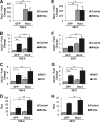Receptor tyrosine kinase-like orphan receptor 2 (Ror2) expression creates a poised state of Wnt signaling in renal cancer
- PMID: 23893409
- PMCID: PMC3764835
- DOI: 10.1074/jbc.M113.466086
Receptor tyrosine kinase-like orphan receptor 2 (Ror2) expression creates a poised state of Wnt signaling in renal cancer
Abstract
Expression of the receptor tyrosine kinase-like orphan receptor 2 (Ror2) has been identified in an increasing array of tumor types and is known to play a role as an important mediator of Wnt signaling cascades. In this study, we aimed to clarify Ror2 interactions with the Wnt pathways within the context of renal cell carcinoma (RCC). An examination of Ror2 expression in primary human RCC tumors showed a significant correlation with several Wnt signaling genes, including the classical feedback target gene Axin2. We provide evidence that Ror2 expression results in a partially activated state for canonical Wnt signaling through an increased signaling pool of β-catenin, leading to an enhancement of downstream target genes following Wnt3a stimulation in both renal and renal carcinoma-derived cells. Additionally, inhibition of low-density lipoprotein receptor-related protein 6 (LRP6) with either siRNA or dickkopf decreased the response to Wnt3a stimulation, but no change was seen in the increased β-catenin pool associated with Ror2 expression, suggesting that LRP6 cofactor recruitment is necessary for a Wnt3a-induced signal but that it does not participate in the Ror2 effect on β-catenin signaling. These results highlight a new role for Ror2 in conveying a tonic signal to stabilize soluble β-catenin and create a poised state of enhanced responsiveness to Wnt3a exogenous signals in RCC.
Keywords: Cancer; RCC; Receptor Tyrosine Kinase; Renal Cell Carcinoma; Ror2; Signaling; Wnt Signaling; Wnt3a; β-Catenin.
Figures








Similar articles
-
Wnt-5a-Receptor Tyrosine Kinase-Like Orphan Receptor 2 Signaling Provokes Metastatic Colonization and Angiogenesis in Renal Cell Carcinoma, and Prunetin Supresses the Axis Activation.Am J Pathol. 2024 Oct;194(10):1967-1985. doi: 10.1016/j.ajpath.2024.07.003. Epub 2024 Jul 26. Am J Pathol. 2024. PMID: 39069169
-
Protein kinase A activation enhances β-catenin transcriptional activity through nuclear localization to PML bodies.PLoS One. 2014 Oct 9;9(10):e109523. doi: 10.1371/journal.pone.0109523. eCollection 2014. PLoS One. 2014. PMID: 25299576 Free PMC article.
-
Ror2, a developmentally regulated kinase, promotes tumor growth potential in renal cell carcinoma.Oncogene. 2009 Jul 9;28(27):2513-23. doi: 10.1038/onc.2009.116. Epub 2009 May 18. Oncogene. 2009. PMID: 19448672 Free PMC article.
-
Dysregulation of Wnt/β-catenin signaling by protein kinases in hepatocellular carcinoma and its therapeutic application.Cancer Sci. 2021 May;112(5):1695-1706. doi: 10.1111/cas.14861. Epub 2021 Apr 6. Cancer Sci. 2021. PMID: 33605517 Free PMC article. Review.
-
Cellular and molecular mechanisms implicated in the dual role of ROR2 in cancer.Crit Rev Oncol Hematol. 2022 Feb;170:103595. doi: 10.1016/j.critrevonc.2022.103595. Epub 2022 Jan 13. Crit Rev Oncol Hematol. 2022. PMID: 35032666 Review.
Cited by
-
ROR2 regulates self-renewal and maintenance of hair follicle stem cells.Nat Commun. 2022 Aug 1;13(1):4449. doi: 10.1038/s41467-022-32239-7. Nat Commun. 2022. PMID: 35915068 Free PMC article.
-
Bioinformatics-Based Identification of MicroRNA-Regulated and Rheumatoid Arthritis-Associated Genes.PLoS One. 2015 Sep 11;10(9):e0137551. doi: 10.1371/journal.pone.0137551. eCollection 2015. PLoS One. 2015. PMID: 26359667 Free PMC article.
-
Upregulation of non-canonical Wnt ligands and oxidative glucose metabolism in NASH induced by methionine-choline deficient diet.Trends Cell Mol Biol. 2018;13:47-56. Trends Cell Mol Biol. 2018. PMID: 30853754 Free PMC article.
-
Molecular landscape of clear cell renal cell carcinoma: targeting the Wnt/β-catenin signaling pathway.Discov Oncol. 2025 Apr 14;16(1):524. doi: 10.1007/s12672-025-02228-5. Discov Oncol. 2025. PMID: 40227498 Free PMC article. Review.
-
Targeting the ROR1 and ROR2 receptors in epithelial ovarian cancer inhibits cell migration and invasion.Oncotarget. 2015 Nov 24;6(37):40310-26. doi: 10.18632/oncotarget.5643. Oncotarget. 2015. PMID: 26515598 Free PMC article.
References
-
- Li V. S., Ng S. S., Boersema P. J., Low T. Y., Karthaus W. R., Gerlach J. P., Mohammed S., Heck A. J., Maurice M. M., Mahmoudi T., Clevers H. (2012) Wnt signaling through inhibition of β-catenin degradation in an intact Axin1 complex. Cell 149, 1245–1256 - PubMed
-
- Angers S., Moon R. T. (2009) Proximal events in Wnt signal transduction. Nat. Rev. Mol. Cell Biol. 10, 468–477 - PubMed
-
- Wright T. M., Brannon A. R., Gordan J. D., Mikels A. J., Mitchell C., Chen S., Espinosa I., van de Rijn M., Pruthi R., Wallen E., Edwards L., Nusse R., Rathmell W. K. (2009) Ror2, a developmentally regulated kinase, promotes tumor growth potential in renal cell carcinoma. Oncogene 28, 2513–2523 - PMC - PubMed
-
- Edris B., Espinosa I., Mühlenberg T., Mikels A., Lee C. H., Steigen S. E., Zhu S., Montgomery K. D., Lazar A. J., Lev D., Fletcher J. A., Beck A. H., West R. B., Nusse R., van de Rijn M. (2012) ROR2 is a novel prognostic biomarker and a potential therapeutic target in leiomyosarcoma and gastrointestinal stromal tumour. J. Pathol. 227, 223–233 - PMC - PubMed
Publication types
MeSH terms
Substances
Grants and funding
- T32 CA009156/CA/NCI NIH HHS/United States
- R25GM055336/GM/NIGMS NIH HHS/United States
- F31 CA132543/CA/NCI NIH HHS/United States
- R25 GM055336/GM/NIGMS NIH HHS/United States
- F31CA132543/CA/NCI NIH HHS/United States
- T32 CA071341/CA/NCI NIH HHS/United States
- R01 CA121781/CA/NCI NIH HHS/United States
- T32 GM007092/GM/NIGMS NIH HHS/United States
- T32 HL069768-09/HL/NHLBI NIH HHS/United States
- T32 HL069768/HL/NHLBI NIH HHS/United States
- T32 GM008719/GM/NIGMS NIH HHS/United States
- T32-CA009156/CA/NCI NIH HHS/United States
- HHMI/Howard Hughes Medical Institute/United States
- T32 ES007126/ES/NIEHS NIH HHS/United States
LinkOut - more resources
Full Text Sources
Other Literature Sources
Medical
Miscellaneous

